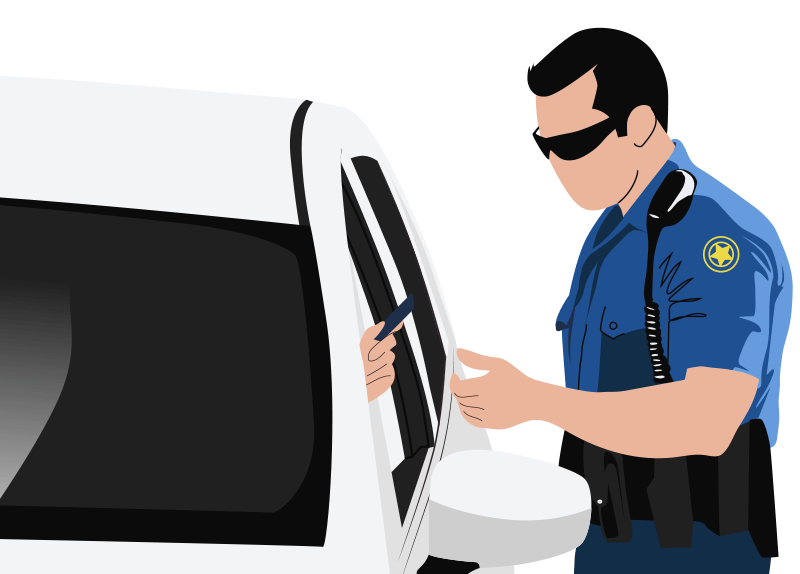Criminal Defense
Vandalism Charges and Penalties
by Pat Austin, Esq.

Vandalism is a criminal offense that typically involves the intentional destruction or damage of property without the consent of the property’s owner. Vandalism charges can carry significant legal consequences, including large monetary fines, jail time, and probation. Understanding the laws and potential penalties surrounding vandalism is critically important if you are confronting such charges.
Vandalism can encompass a wide range of destructive acts, including:
- Defacing public property with graffiti
- Defacing or damaging a motor vehicle
- Egging a home
- Smashing windows or mailboxes
Even if you simply place a bumper sticker on someone else’s vehicle or spray paint your name on someone’s fence, these acts are, legally speaking, considered vandalism.
Vandalism Laws Vary by State
The exact legal definition of vandalism will typically vary across jurisdictions. For example, the legal definition of vandalism in Virginia is the “unlawful or intentional destruction or damaging of property,” according to Virginia Code §18.2-137. In contrast, the definition of vandalism in Texas (known as “criminal mischief” under the Lone Star State’s penal code) is broadly defined as “willful behavior aimed at destroying, altering, or defacing property belonging to another.”
It is important to note that vandalism charges can apply to both private and public property. This means you can be charged with committing an act of vandalism if you allegedly deface or damage a privately-owned vehicle, home, business or public property like a public school, playground, or city bus.
Vandalism Penalties: Misdemeanor or Felony Offense?
Acts of vandalism are generally charged as misdemeanor criminal offenses. A misdemeanor offense, in most jurisdictions, carries penalties that include monetary fines and, potentially, being ordered to serve up to one year in jail.
Vandalism that results in significant damage to property valued above specific statutory thresholds, however, may be charged as a felony. Additionally, if the alleged vandalism results in any bodily injuries to individuals, the charges may be enhanced. A judge will likely consider the extent of the injuries and the intent behind the act when determining the severity penalties.
In addition, if other acts occur during the commission of the alleged vandalism, it could lead to more severe criminal charges. For example, an act of vandalism could be coupled with a criminal charge of burglary, criminal trespass, or disturbing the peace. If you are charged with a felony offense, you could be ordered to serve more than a year in a state prison, along with paying significant fines. If that was not bad enough, a felony conviction will remain on your record for the foreseeable future, which means it could haunt you for decades and impact your ability to pursue certain educational and professional endeavors, secure loans, or qualify to rent an apartment.
Property Valuation’s Impact on Vandalism Charges
In many jurisdictions, the value of the alleged damaged property will impact whether the vandalism is considered a misdemeanor or a felony.
Property valued at less than $1,000 will generally be charged as a misdemeanor. Property valued at $1,000 or more could be charged as a felony. Again, this amount will differ among states. For example, some states set a $500 limit to misdemeanors but consider any damage to a motor vehicle a felony.
Vandalism Charges and Jail Time
If you are charged with vandalism – whether it is a misdemeanor or felony charge – you need to take the charges seriously and proactively take steps to mount a compelling and credible defense. Why? Because both misdemeanor vandalism and felony vandalism carry the potential of jail time, if convicted.
As mentioned, the specific penalties associated with a vandalism charge depends primarily on the state in which you reside. For example, if you reside in California, a misdemeanor vandalism conviction can result in you having to serve up to a full year in jail, followed by probation, according to Section 594 of California’s Penal Code. If convicted of felony vandalism, you could be ordered to serve a jail term of 16 months, two years, or even three years (depending on the specific facts of your case). If you have prior criminal convictions on your record, many states also authorize a judge to “enhance” the penalties for a subsequent conviction. In California, someone with a prior vandalism conviction on their record who is convicted again will be required to serve time in jail.
Vandalism and Hate Crimes
Another factor in determining whether vandalism will be charged as a misdemeanor or felony offense is the presence of any hate symbols or messages. This is because hate crimes are treated more seriously and carry enhanced penalties in many states. There is also the possibility of federal charges for certain hate crimes.
Hate crimes as defined by the United States Department of Justice (DOJ) are crimes motivated by bias, which means they go beyond acts of anger or dislike. Rather, a hate crime can occur if there is evidence of “bias against people with specific characteristics like race, national origin, gender, sexual orientation, religion or disability,” according to CNN. Notably, the DOJ classifies certain types of property damage as a chargeable hate crime.
If you reside in Florida and are convicted of vandalism (known as “criminal mischief” under Florida law), you could be ordered to serve up to a full year in jail for a misdemeanor offense, according to Section 806.13, Florida Statutes. If you are convicted of felony vandalism in Florida, you could be ordered to serve a 5-year prison term. The extent of the penalties in Florida are generally dictated by the amount of the damage and whether you have a criminal record.
Court Proceedings for Vandalism Charges
If you are charged with vandalism, you may be required to make multiple court appearances. Though, the need to appear in court may be impacted by the severity of the vandalism charges. For example, if you are charged with felony vandalism, there is a greater probability you will need to appear in court for an arraignment or to enter your plea (i.e. guilty or not guilty) regarding the charges.
The need to go to court can also be impacted by your ability to potentially negotiate a plea bargain and whether you have a criminal record. If you have a clean record and are charged with misdemeanor vandalism as a first time offender, there is a higher probability that you could negotiate a plea agreement to serve community service or another “lighter” penalty. The ability to plea bargain is also a viable option for juvenile offenders who may be confronting vandalism charges stemming from an incident at their local school.
If you decide to exercise your right to a trial by jury, you will need to appear in court during the trial.
You may also need to appear in court if the owner of the alleged vandalized property files a civil action against you. Many states allow an alleged vandalism victim to file a civil lawsuit against the alleged vandalism offender. The property owner would typically file a civil case to pursue financial restitution for the cost of repairing or replacing the vandalized property.
What Proof is Needed to Charge Someone with Vandalism?
There are specific legal elements that must be met in order to convict you of committing vandalism. The prosecutor (on behalf of the government) carries the legal burden of proving you committed each of the elements listed below:
- Actual damage to property: In general, vandalism requires evidence of specific actions taken that led to the actual damage of public or private property. This means there needs to be evidence reflecting actual graffiti, etching, or other demarcations that allegedly defaced or damaged the property. Allegedly putting stickers, posters, or other types of signage on public or private property could also be considered an act of vandalism.
- Alleged vandalized property was owned by another party: Apart from actual damage, there needs to be evidence that the alleged vandalized property is owned or possessed by another party, or parties. In addition, there needs to be evidence substantiating the allegation that you damaged the property against the owner’s wishes. For example, it would not be feasible to charge someone with vandalism if they damaged or defaced their own property.
- Alleged vandalism was intentional: It is not possible, legally, to accidentally commit an act of vandalism. For example, if you are painting your fence and accidentally spill paint on your neighbor’s fence, this incident would not rise to the level of being considered vandalism. To be convicted of committing vandalism, there needs to be sufficient evidence indicating you intended to damage or deface someone’s property.
If charged with a crime like vandalism, never forget that you are innocent until proven guilty in a court of law.
Defenses to Charges of Alleged Vandalism
Accordingly, there are an array of potential defenses that can be raised to combat vandalism charges. Some common defenses include:
- Lack of evidence that the damage resulted from your conduct
- No evidence that the alleged victim actually owned the property at issue
- No evidence that damage to the property was willful or intentional
- Evidence to indicate the damage was caused by accident
Reporting Vandalism to the Police
If you witnessed an act of vandalism, or discovered vandalized property, it is recommended to report the incident to police. Documenting and reporting the incident can assist law enforcement in identifying the culprit.
Most jurisdictions allow online reporting for non-violent crimes like vandalism. For example, Baltimore and New York City allow residents to file certain police reports through an online portal.









